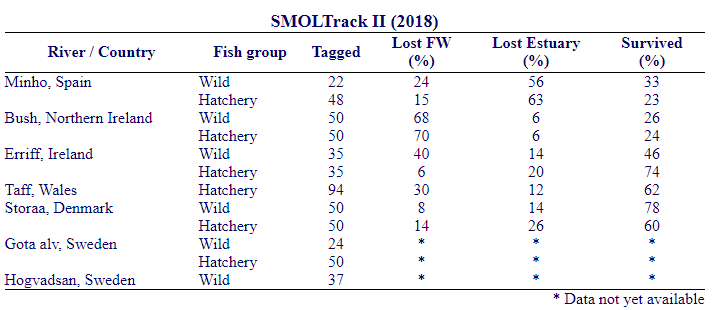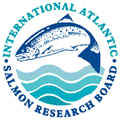SMOLTrack II
SMOLTrack II: Comparing mortality of European salmon populations at sea using multiple-method telemetry studies

The SMOLTrack II project was initiated in January 2018, involving partners from Denmark, England, Ireland, Northern Ireland, Spain and Sweden. The project aimed to expand the platform and collaboration of SMOLTrack I by including more partners (Sweden is now included, taking the total number of study sites to eight). The geographical span of the project now ranges over all of the salmon distribution area in the EU from north to south and east to west.
The project aims to identify specific predators causing the documented loss of smolts from the SMOLTrack I project and make comparisons between survival of wild and hatchery-reared salmon smolts. Blood sampling is being used to evaluate smolt quality and sex as they exit rivers to test if gender and physiological background affect the chance of survival. The project carried out a pilot study to test the feasibility to tag genetically-assigned large salmon at the Faroe Islands or Greenland and track the return migration.
Progress and Findings
The first project tagging (smolts) in 2018 has been completed and overall results are shown below. The samples collected in 2018 for sexing the salmon are under analysis in Northern Ireland (at AFBI). After these analyses the samples will be reallocated to Cefas (England) and / or DTU Aqua (Denmark) for physiological analyses.
The radio tagging in 2019 has been undertaken, but data are not yet finally compiled (automatic listening station and manual tracking has to be completed first). A workshop was held in Pontevedra, Spain in March 2018 (in prolongation of the SMOLTrack I workshop), where studies and analysis were discussed and agreed and the Standard Operating Procedure for SMOLTrack I was updated and adapted for the present project, including procedures for blood sampling and genetic analyses.
The experimental fieldwork took place and the results are much in line with 2017. In general, the wild smolts have a slightly better survival than hatchery smolts (except for the River Erriff), but the difference is less pronounced than may have been expected. The radio-telemetry work provided information about the exact cause of smolt loss and both avian and mammalian predators were found to prey on smolts.
The pilot study on salmon at sea has run into challenges of accessing suitable salmon for tagging. Work is being done to prepare for the potential tagging of adult salmon off East Greenland and, if this proves unfeasible, to discuss potential other solution with North American colleagues before their tagging operation in late Autumn 2019.

Total project cost (including in-kind contributions): €539,000
EU contribution to the International Atlantic Salmon Research Fund: €260,000
Partners: DTU Aqua (National Institute of Aquatic Resources), Denmark; Centre for Environment, Fisheries & Aquaculture Science (Cefas), England, UK; University of Göteborg, Sweden, Xunta de Galicia, Spain; Agri-Food and Biosciences Institute (AFBI), Northern Ireland, UK and Inland Fisheries Ireland, Ireland.
More information on the SMOLTrack Projects can be found at https://www.smoltrack.eu/
